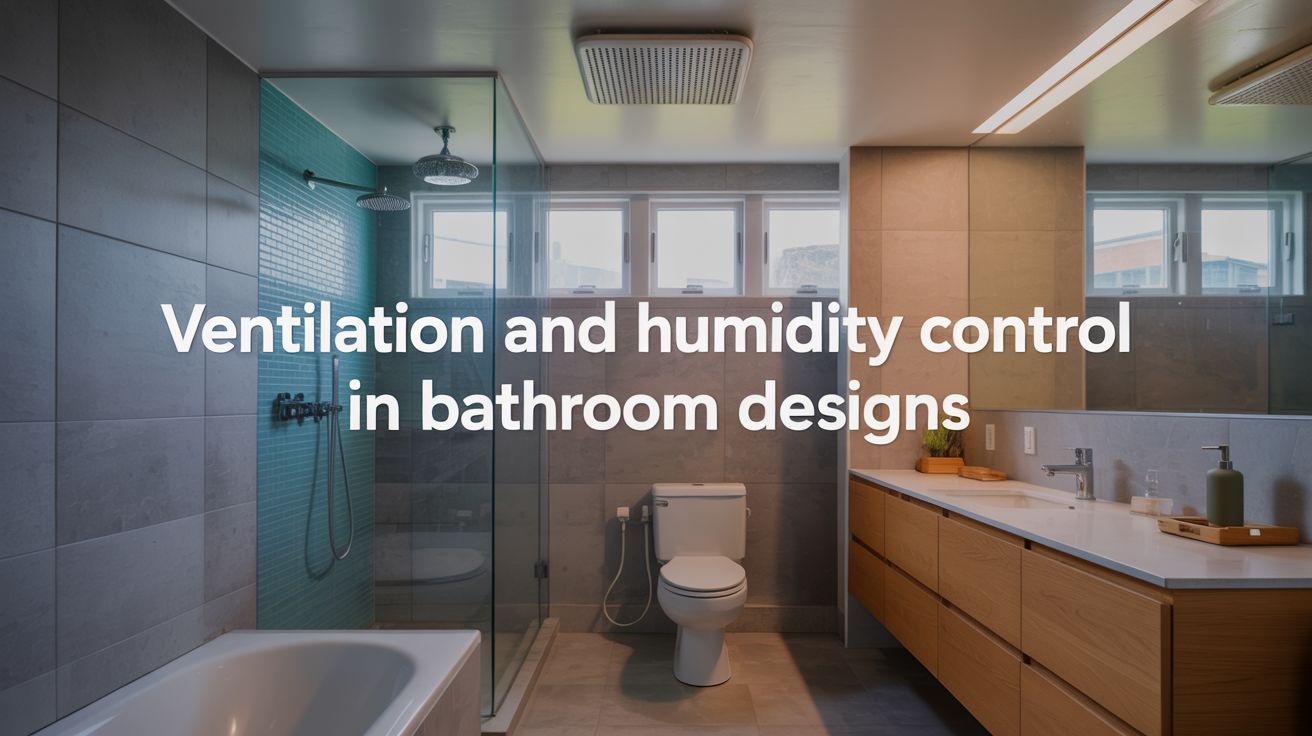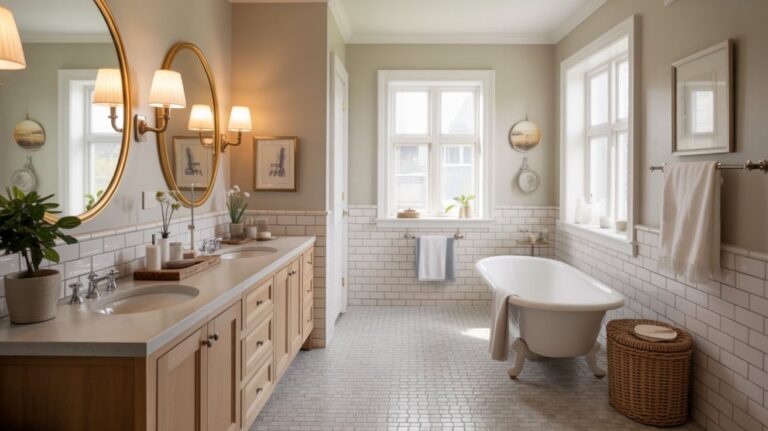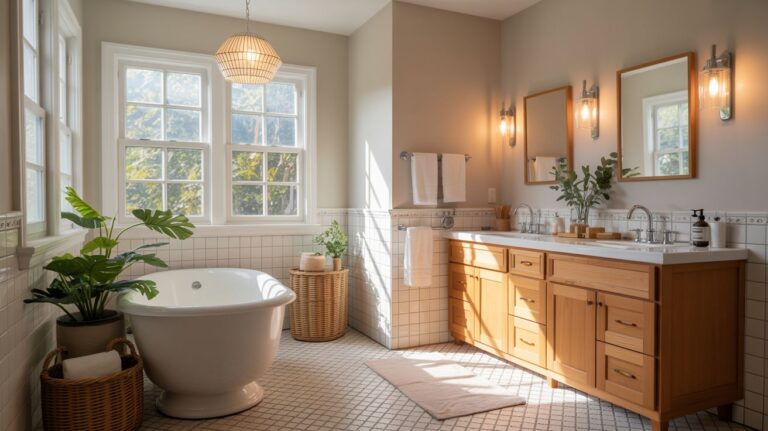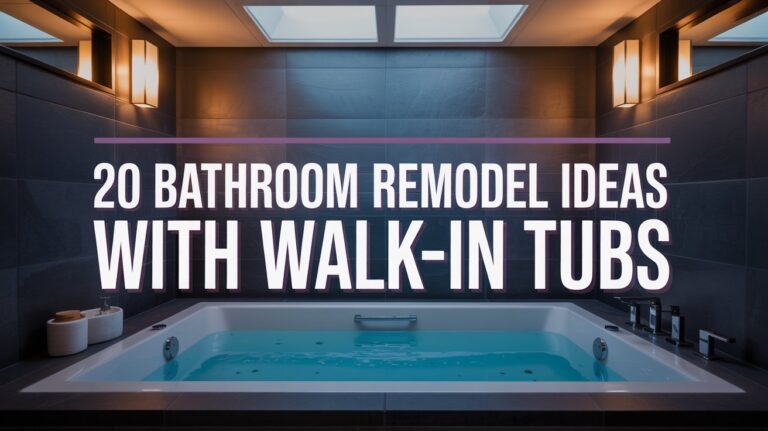The Significance of Ventilation and Humidity Control in Bathroom Designs
I have been, or can be if you click on a link and make a purchase, compensated via a cash payment, gift, or something else of value for writing this post. As an Amazon Associate, I earn from qualifying purchases. Please read my full Affiliate Disclosure for more information.
Ventilation and humidity control are essential in bathroom design to deter mold, protect materials, and sustain comfort and durability. You’ll manage moisture from showers with effective air exchange and surface diffusion, minimizing condensation and hotspots on tiles and fixtures. Precise humidity targets (40–60% RH) support IAQ, reduce microbial growth, and prevent damage. Integrate sensor-driven, energy-efficient systems with durable, moisture-resistant finishes and thoughtful design. If you continue, you’ll uncover how to optimize performance across layouts and finishes.
Key Takeaways
- Proper ventilation reduces moisture buildup, limiting mold growth and material degradation in bathrooms.
- Humidity control enhances occupant comfort by preventing condensation on windows and cold surfaces.
- Balanced exhaust and filtration improve indoor air quality by lowering particulates and microbial metabolites.
- Integrated design aligns ducts, fixtures, and finishes for reliable moisture management and easier maintenance.
- Real-time humidity sensing and smart controls optimize energy use while sustaining target moisture levels.
Understanding Moisture Dynamics in Bathrooms
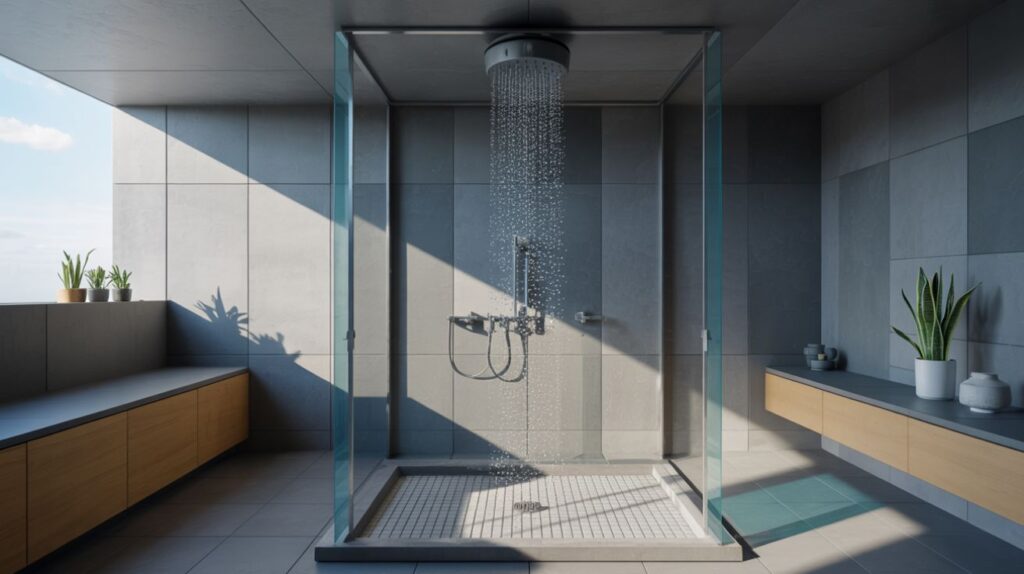
Moisture dynamics in bathrooms are driven by a combination of moisture generation, air exchange, and surface interactions, which together determine humidity levels and condensation patterns. You analyze how moisture absorption by surfaces and the efficiency of air circulation influence transient humidity and stain risk. Rapid generation from showers increases surface wetting, while slower diffusion through porous materials moderates peak values. Effective air circulation mitigates local hotspots, reducing condensation on tiles and fixtures. Consider material moisture ratings, surface finishes, and ventilation timing to predict saturation points. Accurate modeling supports targeted control strategies, improving comfort, durability, and moisture-related maintenance.
Health Impacts of Inadequate Ventilation
Exposure to elevated humidity fosters mold growth on surfaces and materials, which can compromise indoor air quality and material integrity. Inadequate ventilation increases the concentration of airborne particulates and microbial metabolites, elevating exposure risks to occupants. You should consider how humidity control directly relates to respiratory health risks from stale air and the mechanisms by which moisture-related dampness impacts indoor environments.
Humidity and Mold Growth
In bathrooms, high humidity provides ideal conditions for mold growth, which can begin within 24 to 48 hours of moisture accumulation and escalate if ventilation remains inadequate. You’ll observe that elevated moisture sustains fungal activity on surfaces, substrates, and seals, increasing material degradation and potential allergen exposure. Effective humidity control reduces spore viability and limits colonization, reinforcing the need for continuous air exchange and targeted dehumidification. Implement mold prevention strategies by minimizing water traps and ensuring consistent drying between uses. Incorporate moisture barriers during construction to restrict moisture ingress, supporting long‑term bathroom durability and indoor air quality.
Respiratory Health Risks From Stale Air
Inadequate ventilation doesn’t just foster mold; it also permits stale air to accumulate, elevating the concentration of indoor pollutants and reducing the supply of fresh oxygen in occupied spaces. You can directly influence health outcomes by evaluating air quality indicators and selecting effective ventilation systems. Stale air increases exposure to volatile compounds, particulates, and biological contaminants, contributing to respiratory irritation, allergy symptoms, and, in some cases, reduced lung function over time.
- Monitor air quality metrics regularly
- Choose efficient, properly installed ventilation systems
- Maintain airtight integrity and filtration effectiveness
Key Ventilation Strategies for Modern Bathrooms
Effective bathroom ventilation hinges on selecting strategies that balance moisture removal, IAQ, and energy efficiency. You evaluate exhaust rates, fan control, and zoning to match occupancy patterns and moisture sources. Mechanical options—continuous vs intermittent exhaust, humidity-sensing controls, and duct design—target reliable air exchange without drafts. Natural ventilation can supplement when conditions permit, but you assess air quality implications and infiltration risks. Bring in demand-controlled ventilation where possible to minimize energy use while maintaining performance. Combine balanced systems with passive measures, such as infiltration barriers and operable windows, to optimize control. This approach prioritizes precise, evidence-based decisions.
Humidity Targets and Thermal Comfort
Maintaining target humidity levels in bathrooms directly influences thermal comfort and occupant satisfaction, as moisture control affects perceived temperature, surface condensation, and mold risk. You’ll align targets with occupant activities, ensuring stable conditions without overshoot. Key metrics include 40–60% RH for most zones and lower limits during steam events to prevent condensation.
- moisture sensors inform real-time adjustments
- humidity levels guide ventilation setpoints
- maintain consistency to avoid thermal strain
In practical terms, calibrate sensors, verify responses, and document deviations to sustain comfort, energy efficiency, and indoor air quality.
Selecting Durable Materials for Damp Environments
Selecting Durable Materials for Damp Environments requires a structured approach that prioritizes moisture resistance, mold resistance, and long-term performance. You will evaluate material classes by ingress resistance, degradation potential, and maintenance needs, then align choices with anticipated humidity profiles. Choose substrates and finishes proven in damp conditions, focusing on compatibility with sealing systems and joints. Emphasize water resistant finishes for exposed surfaces and ensure concealment strategies minimize water intrusion pathways. Prioritize corrosion resistant fixtures in plumbing and hardware to extend service life. Document performance data, installation requirements, and warranty terms to support durable, low-maintenance bathroom environments.
Bath Exhaust Fans: Sizing and Placement Guidance
Proper sizing and placement of bath exhaust fans are essential to control humidity and prevent mold growth; the goal is to achieve sufficient room air exchanges without creating excessive noise or energy use.
- exhaust fan sizing: calculate required CFM based on room volume and usage, adjusting for ceiling height and intermittent peak loads
- fan placement: position at or near the shower or tub, with short duct runs and minimal bends to reduce static pressure
- system integration: consider door undercuts, makeup air, and timer or humidity controls to ensure consistent performance
This approach emphasizes precision, reliability, and user clarity.
Smart Ventilation Technologies to Consider
Smart ventilation technologies integrate sensor-driven ventilation to modulate operation based on real-time humidity and occupancy, optimizing air exchange without overventilating. Pair this with targeted humidity control methods to maintain comfort and protect surfaces, while prioritizing quiet, efficient fans that minimize noise and energy use. This approach establishes a precise framework for selecting components that balance performance, reliability, and system longevity.
Sensor-driven Ventilation
Sensor-driven ventilation uses ambient and localized data to activate exhaust and supply fans only when humidity or odor thresholds are exceeded, reducing energy use while maintaining air quality.
- sensor calibration guarantees consistent trigger points across fixtures
- air quality sensors monitor volatile compounds and particulates for adaptive responses
- thresholds adapt to occupancy, time of day, and weather influences to optimize exhaust and intake
You’ll gain precise control with reduced energy waste, smoother operation, and clearer IAQ feedback. This approach minimizes over-ventilation, lowers heat loss, and supports compliance with design standards by leveraging sensor data and calibrated workflows.
Humidity Control Methods
What humidity regulation methods are most effective in smart ventilation systems, and how do they balance comfort with energy efficiency? You engage with adaptive sensing, integrating humidity monitoring to modulate airflow precisely as indoor conditions shift. Demand-controlled ventilation uses real-time data, minimizing overrun while maintaining target RH ranges. Humidity probes, coupled with predictive models, reduce waste heat and dampness, improving occupant comfort without energy spikes. Consider ventilation aesthetics when configuring ducts, vents, and controls to minimize noise and visual impact while preserving performance. System calibration and fault detection ensure reliability, avoiding stale air. Informed selection supports durable, responsive humidity management.
Quiet, Efficient Fans
Quiet, efficient fans are the backbone of effective demand-controlled ventilation, balancing low noise with energy-conscious performance. You assess how airflow optimization targets real-time humidity needs while minimizing power draw and retrofits. Key trends include variable-speed motors, smart controls, and acoustically optimized housings that reduce fan noise without sacrificing extraction rate.
- Airflow optimization strategies match extraction to occupancy and moisture generation
- Noise reduction through enclosure design, gyroscopic dampening, and dashboard-informed control
- Energy efficiency via EC motors, demand-controlled sensing, and adaptive run-time
This approach yields precise humidity control with predictable performance and lower energy use.
Designing for Odor Control and Air Quality
Effective odor control and air quality in bathrooms hinges on a holistic strategy that combines source management, ventilation rates, and filtration. You assess contaminant sources, implement targeted extraction, and choose filtration with appropriate MERV rating to reduce particulates and odors without overterrain. Air exchange should align with room size, occupancy, and activity, preserving comfort while removing emissions promptly. Consider air freshener placement to minimize plume concentration near occupants and sensors, ensuring predictable performance. Decorative vent covers should balance airflow with aesthetics while not impeding capture efficiency. Document performance metrics, update controls, and verify that the system maintains consistent air quality under varied use.
Maintenance Practices That Preserve Performance
Maintenance practices keep ventilation and humidity control performing as designed. You maintain system effectiveness through proactive inspection, timely filter changes, and precision calibration to sustain air quality and air filtration standards.
- Schedule routine checks for seals, dampers, and drainage to prevent bypass and moisture buildup
- Replace filters per manufacturer guidance, verify airflow, and record pressure differentials
- Calibrate sensors and controllers when readings drift, ensuring consistent humidity targets
These steps minimize corrosion, mold risk, and energy waste while preserving performance. You’ll benefit from stable indoor air quality, reliable humidity control, and predictable maintenance cycles through disciplined upkeep and documentation.
Integrating Ventilation With Overall Bathroom Design
When you plan bathroom layout, integrate ventilation considerations early to align with space, fixtures, and lighting. Emphasize integrated ventilation planning that accounts for load paths, quiet operation, and balance with humidity-smart design cues across surfaces and storage. This approach supports data-driven performance targets and reduces retrofit risk by treating ventilation as a core design constraint, not an afterthought.
Integrated Ventilation Planning
Integrated ventilation planning requires aligning exhaust, supply, and makeup air with the bathroom’s overall layout and usage patterns. You’ll coordinate pathways to minimize cross-contamination, balance pressure, and maintain comfort while preserving aesthetics. The approach integrates ventilation with natural lighting considerations and aesthetic finishes, ensuring systems don’t obstruct sightlines or materials.
- Align duct runs with architectural joints to reduce thermal bridges
- Position intakes and exhausts to optimize humidity control without glare
- Account for zoning and startup/shutoff sequences to preserve energy efficiency
This disciplined integration yields predictable performance, clearer maintenance, and a cohesive design narrative.
Humidity-Smart Design Integration
Humidity-smart design integrates ventilation with the bathroom’s overall aesthetic and functional goals, ensuring humidity control acts as a design constraint rather than an afterthought. You evaluate how layout, fixtures, and finishes influence air movement, selecting components that support airflow optimization without visual clutter. Integrate quiet, efficient ventilation with zones for showering and vanity use, ensuring ducts, grills, and control interfaces align with architectural lines. Address moisture barriers at envelope penetrations and around plumbing to minimize condensate pathways. This approach links performance metrics to design choices, enabling predictable humidity budgets and easier maintenance while preserving comfort, durability, and perceived quality.
Conclusion
In summary, you must treat ventilation and humidity as core performance metrics. Poor air exchange or excessive moisture trigger mold, degraded finishes, and discomfort, while well-tuned systems sustain indoor air quality and thermal comfort. You’ll benefit from targeted airflow, durable materials, and smart controls that adapt to use patterns. Maintain performance through regular checks and sealing, and integrate ventilation with lighting, routing, and odor management to optimize overall bathroom health and durability.
